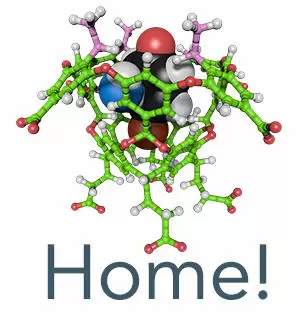Alagbe, B. D.; Gibb, B. C.; Ashbaugh, H. S. Evolution of the Free Energy Landscapes of n-Alkane Guests Bound within Supramolecular Complexes. The Journal of Physical Chemistry B 2021, 125, 7299-7310.
2021
Shusterman-Krush, R.; Tirukoti, N. D.; Bandela, A. K.; Avram, L.; Allouche-Arnon, H.; Cai, X.; Gibb, B. C.; Bar-Shir, A. Single Fluorinated Agent for Multiplexed 19F-MRI with Micromolar Detectability Based on Dynamic Exchange. Angewandte Chemie International Edition 2021, 60, 15405-15411.
Abstract The weak thermal polarization of nuclear spins limits the sensitivity of MRI, even for MR-sensitive nuclei as fluorine-19. Therefore, despite being the source of inspiration for the development of background-free MRI for various applications, including for multiplexed imaging, the inability to map very low concentrations of targets using 19F-MRI raises the need to further enhance this platform s capabilities. Here, we employ the principles of CEST-MRI in 19F-MRI to obtain a 900-fold signal amplification of a biocompatible fluorinated agent, which can be presented in a “multicolor” fashion. Capitalizing on the dynamic interactions in host–guest supramolecular assemblies in an approach termed GEST, we demonstrate that an inhalable fluorinated anesthetic can be used as a single 19F-probe for the concurrent detection of micromolar levels of two targets, with potential in vivo translatability. Further extending GEST with new designs could expand the applicability of 19F-MRI to the mapping of targets that have so-far remained non-detectable.
Ashbaugh, H. S.; Gibb, B. C.; Suating, P. Cavitand Complexes in Aqueous Solution: Collaborative Experimental and Computational Studies of the Wetting, Assembly, and Function of Nanoscopic Bowls in Water. The Journal of Physical Chemistry B 2021, 125, 3253-3268.
Yao, W.; Wang, K.; Wu, A.; Reed, W. F.; Gibb, B. C. Anion binding to ubiquitin and its relevance to the Hofmeister effects. Chemistry Science 2021, 12, 320-330.
Although the non-covalent interactions between proteins and salts contributing to the Hofmeister effects have been generally mapped, there are many questions regarding the specifics of these interactions. We report here studies involving the small protein ubiquitin and salts of polarizable anions. These studies reveal a complex interplay between the reverse Hofmeister effect at low pH, the salting-in Hofmeister effect at higher pH, and six anion binding sites in ubiquitin at the root of these phenomena. These sites are all located at protuberances of preorganized secondary structure, and although stronger at low pH, are still apparent when ubiquitin possesses no net charge. These results demonstrate the traceability of these Hofmeister phenomena and suggest new strategies for understanding the supramolecular properties of proteins.
2020
Cai, X.; Kataria, R.; Gibb, B. C. Intrinsic and extrinsic control of the pKa of thiol guests inside yocto-liter containers. Journal of the American Chemical Society 2020, 142, 8291-8298.
Barnett, W.; Sullivan, M. R.; Long, J. A.; Tang, D.; Nguyen, T.; Ben-Amotz, D.; Gibb, B. C.; Ashbaugh, H. S. Spontaneous Drying of Non-Polar Deep-Cavity Cavitand Pockets in Aqueous Solution. Nature Chemistry 2020, 12, 589–594.
Tang, D.; Dwyer, T.; Bukannan, H.; Blackmon, O.; Delpo, C.; Barnett, W.; Gibb, B. C.; Ashbaugh, H. S. Pressure Induced Wetting and Dewetting of the Nonpolar Pocket of Deep-Cavity Cavitands in Water. The Journal of Physical Chemistry B 2020, 124, 4781-4792.
Suating, P.; Nguyen, T. T.; Ernst, N. E.; Wang, Y.; Jordan, J. H.; Gibb, C. L. D.; Ashbaugh, H. S.; Gibb, B. C. Proximal charge effects on guest binding to a non-polar pocket. Chem. Sci. 2020, 11, 3656-3663.
Science still does not have the ability to accurately predict the affinity that ligands have for proteins. In an attempt to address this, the Statistical Assessment of Modeling of Proteins and Ligands (SAMPL) series of blind predictive challenges is a community-wide exercise aimed at advancing computational techniques as standard predictive tools in rational drug design. In each cycle, a range of biologically relevant systems of different levels of complexity are selected to test the latest modeling methods. As part of this on-going exercise, and as a step towards understanding the important factors in context dependent guest binding, we challenged the computational community to determine the affinity of a series of negatively and positively charged guests to two constitutionally isomeric cavitand hosts: octa-acid 1, and exo-octa acid 2. Our affinity determinations, combined with molecular dynamics simulations, reveal asymmetries in affinities between host–guest pairs that cannot alone be explained by simple coulombic interactions, but also point to the importance of host–water interactions. Our work reveals the key facets of molecular recognition in water, emphasizes where improvements need to be made in modelling, and shed light on the complex problem of ligand-protein binding in the aqueous realm.
2019
Wang, K.; Jordan, J. H.; Gibb, B. C. Molecular protection of fatty acid methyl esters within a supramolecular capsule. Chemistry Communications 2019, 55, 11695-11698.
We describe the use of a supramolecular nano-capsule for selective protection of cis- and trans-C18 mono-unsaturated fatty-acid esters. In contrast to earlier studies revealing that protection of smaller esters is dictated by affinity, protection of these larger esters was found to be dependent on the packing motif of the guest.
Wang, K.; Cai, X.; Yao, W.; Tang, D.; Kataria, R.; Ashbaugh, H. S.; Byers, L. D.; Gibb, B. C. Electrostatic Control of Macrocyclization Reactions within Nanospaces. Journal of the American Chemical Society 2019, 141, 6740-6747.

